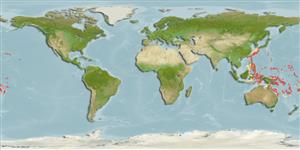Classification / Names
Common names from other countries
Main reference
Size / Weight / Age
Max length : 60.0 cm SL male/unsexed; (Ref. 9821)
Environment
Marine; demersal; depth range 100 - 310 m (Ref. 9821), usually 125 - 250 m (Ref. 82366)
Climate / Range
Tropical, preferred ?; 32°N - 26°S, 116°E - 167°W (Ref. 55)
Distribution
Western Pacific: Samoa to Taiwan and Singapore and from the Ryukyu and Ogasawara islands southward to New Caledonia and northeastern Australia.
Countries | FAO areas | Ecosystems | Occurrences | Introductions
Short description
Dorsal
spines
(total): 10;
Dorsal
soft rays
(total): 10;
Anal
spines: 3;
Anal
soft rays: 8. Eye large, about 3.6 times in head length. Interorbital space convex. Large specimens developing a hump on forehead. Lower jaw protruding slightly. Maxilla scaled. Scale rows on back parallel to lateral line. Pectoral fins long, reaching level of anus. Back and upper sides brown; remainder of head and body silvery white with 4 broad vertical bars on upper side. Fins grayish, whitish or slightly yellowish.
IUCN Red List Status (Ref. 115185)
Threat to humans
Harmless
Human uses
Fisheries: minor commercial
More information
ReferencesAquacultureAquaculture profileStrainsGeneticsAllele frequenciesHeritabilityDiseasesProcessingMass conversion
Tools
Special reports
Download XML
Internet sources
Estimates of some properties based on models
Phylogenetic diversity index
PD50 = 0.5039 many relatives (e.g. carps) 0.5 - 2.0 few relatives (e.g. lungfishes)
Trophic Level
4.0 ±0.66 se; Based on food items.
Resilience
Medium, minimum population doubling time 1.4 - 4.4 years (Preliminary K or Fecundity.)
Vulnerability
Moderate to high vulnerability (46 of 100)
Price category
